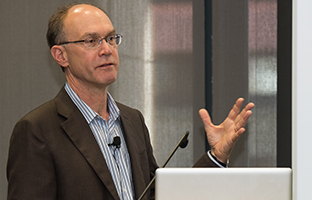Personal Learning at Scale
Over the last three years, we at Stanford have experimented widely with online learning activities, at scale and in campus classes. While the early Stanford MOOCs of 2011 consisted of recorded lecture segments, relatively simple automated quizzes and discussion, inventive instructors have explored a range of new forms, including distributed learning activities around the globe and digital laboratories in humanities classes. Through the Lytics Lab and other research activities, we have also explored the way that data collection, particularly at scale, can inform and improve the learning experience. In this short overview discussion, we will look at some examples, observe selected trends, and ponder a few questions about the future.
 John Mitchell has been Vice Provost at Stanford University since 2012, first as Vice Provost for Online Learning and now in a broader role of Teaching and Learning. Over the past two years, his team has worked with approximately 200 instructors on 400 projects, including on-campus teaching innovation, online courses for public and selected audiences, and improvement of repeated course offerings. As co-director of the Lytics Lab, he is working to improve educational outcomes through data-driven research and iterative design. Mitchell is the Mary and Gordon Crary Family Professor in the School of Engineering, Professor of Computer Science, and (by courtesy) Professor of Electrical Engineering and of Education. His past research has focused on computer security, developing analysis methods and improving network protocol security, authorization and access control, web security, and privacy. Dr. Mitchell’s first research project in online learning started in 2009, when he and six undergraduate students built Stanford CourseWare, an innovative platform that expanded to support interactive video and discussion.CourseWare served as the foundation for initial flipped classroom experiments at Stanford and helped inspire the first massive open online courses (MOOCs)from Stanford. He received his BS from Stanford and his SM and PhD from MIT.
John Mitchell has been Vice Provost at Stanford University since 2012, first as Vice Provost for Online Learning and now in a broader role of Teaching and Learning. Over the past two years, his team has worked with approximately 200 instructors on 400 projects, including on-campus teaching innovation, online courses for public and selected audiences, and improvement of repeated course offerings. As co-director of the Lytics Lab, he is working to improve educational outcomes through data-driven research and iterative design. Mitchell is the Mary and Gordon Crary Family Professor in the School of Engineering, Professor of Computer Science, and (by courtesy) Professor of Electrical Engineering and of Education. His past research has focused on computer security, developing analysis methods and improving network protocol security, authorization and access control, web security, and privacy. Dr. Mitchell’s first research project in online learning started in 2009, when he and six undergraduate students built Stanford CourseWare, an innovative platform that expanded to support interactive video and discussion.CourseWare served as the foundation for initial flipped classroom experiments at Stanford and helped inspire the first massive open online courses (MOOCs)from Stanford. He received his BS from Stanford and his SM and PhD from MIT.